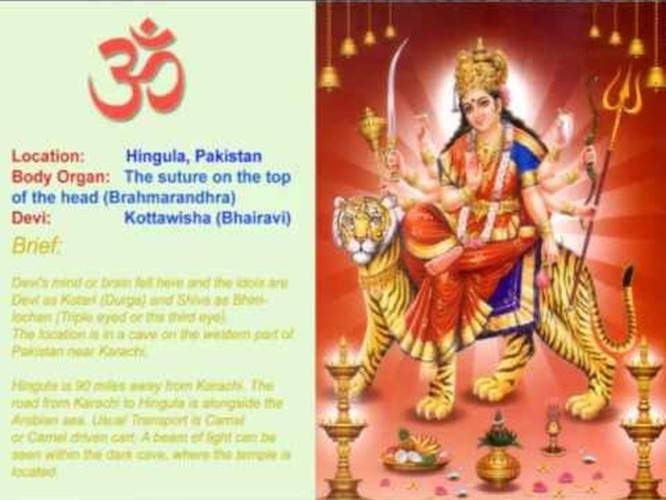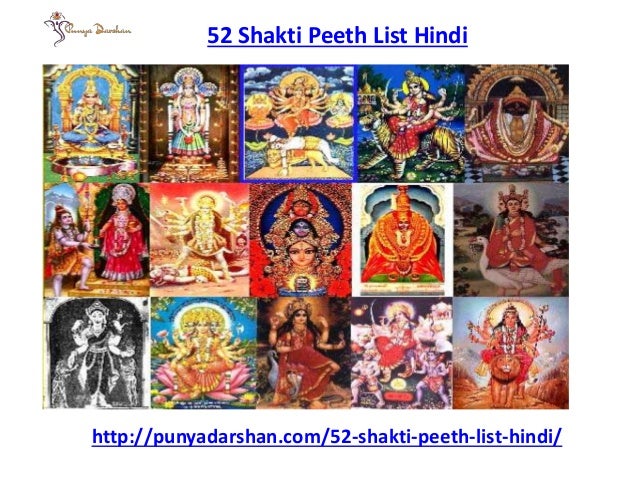
Present day Kurukshetra town or Thanesar ancient Sthaneshwar, at Haryana, India

Kanyashram, Kanyakumari the Bhadrakali temple within the precincts of Kumari temple, Tamil Nadu, India (also thought to be situated in Chittagong, Bangladesh) Varanasi at Manikarnika Ghat on banks of Ganga at Kashi, Uttar Pradesh, India Kireet at Kireetkona village, 3 km from Lalbag Court Road station under district Murshidabad, West Bengal, India This Shakti Peetha is locally known as Falizur Kalibari. Jayanti at Kalajore Baurbhag village of Falzur Pargana under Jayantia Thana of Sylhet district, Bangladesh. Prayag near Sangam at Allahabad, Uttar Pradesh, India Yogaadya at Khirgram under Burdwan district, West Bengal, India Kamgiri, Kamakhya, at the Neelachal hills near Guwahati, capital of Assam, India Trisrota, at Salbari village under Boda division of Jalpaiguri district, West Bengal, India The famous Chandranath Temple on the top of the hill is the Bhairav temple of this Shakti Peetha, not the Shakti Peeth itself. On the Chandranath hill near Sitakunda station of Chittagong District, Bangladesh.

Udaipur, Tripura, at the top of the hills known as Tripura Sundari temple near Radhakishorepur village, a little distance away from Udaipur town of Tripura, India Ujaani, 16 km from Guskara Station under Burdwan district of West Bengal, India Gandaki from Pokhara, Nepal about 125 km on the banks of Gandaki river where Muktinath temple is situatedīahula, on the banks of Ajay river, at Ketugram 8 km from Katwa, Burdwan, West Bengal, India. Manas, under Tibet at the feet of Mount Kailash in Lake Mansarovar, a piece of Stone Nepal, near Pashupatinath Temple at Gujyeshwari Temple This is located near Pathankot, H.P., Jwalamukhi Road. Jwalamukhi, Kangra, Devi’s tongue fell here and the idols are Devi as Ambika (Mother) and Shiva as Unmatta (Furious). Sugandha, situated in Shikarpur, Gournadi, about 20 km from Barisal town, Bangladesh, on the banks of Sonda river.Īmarnath in Kashmir, India from Srinagar through Pahalgam 94 km by Bus, Chandanwari 16 km by walk Naina, a little distance from Sukkur Station from Karachi, Pakistan KanchiPuram, Kamatchi temple,Kamakoti Peetam mentioned in Lalita Sahasram,Trishati,Astothram etc. "Body Part or Ornament" refers to the body part or piece of jewellery that fell to earth, at the location on which the respective temple is built. "Bhairava" refers to the corresponding consort, each a manifestation of Shiva

"Sati" refers to the Goddess worshipped at each location, all being manifestations of Dakshayani, Parvati or Durga) The various parts of the body fell at several spots all through the Indian subcontinent and formed sites which are known as Shakti Peethas today.Īt all Shakti Peethas, the Goddess Shakti is accompanied by Lord Bhairava (a manifestation of Lord Shiva). The other gods intervened to stop this dance, and the Vishnu 's weapon, or Sudarshana Chakra, cut through the corpse of Sati. Still immersed in grief, he picked up the remains of Sati's body, and danced the dance of destruction through the Universe. Sati was unable to bear her father's insults toward her husband, so Dakshayani (the other name of Sati meaning the daughter of Daksha) invoked her yogic powers and immolated herself.Įnraged at the insult and the injury, Shiva destroyed Daksha's sacrifice, cut off Daksha's head, and later replaced it with that of a male goat as he restored him to life due to prayers of all demi gods and Brahmaji. Shiva eventually allowed her to go escorted by his followers.īut Sati, being an uninvited guest, was not given any respect. She had expressed her desire to attend to Shiva who had tried his best to dissuade her from going. The fact that she was not invited did not deter Sati from attending the yagna. Daksha invited all the deities to the yagna except for Shiva and Sati.

Daksha was angry because his daughter Dakshayani also known as Sati had married the 'yogi' God Shiva against his wish. Goddess Sati is the incarnation of Maa Parvati, the kindly goddess of harmony, marital felicity and longevity, with Durga, goddess of strength and valour, and with Mahakali, goddess of destruction of the evil.Īccording to Hindu Mythology and Legend, in the SatYuga, Daksha performed a yajna (Yagya) with a desire to take revenge on Lord Shiva. The Shakti Peethas ( holy places of cosmic and enormous power) are places of worship of Goddess.


 0 kommentar(er)
0 kommentar(er)
